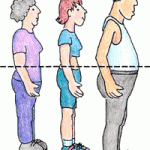Hindsight: Fat Distribution, Not BMI, Determines Cardiovascular Risk
Saturday, October 20, 2012 In 2005, while still at McMaster University, I had the privilege of being involved in a publication that is now, by any standard, already a ‘classic’ in the field of obesity.
In 2005, while still at McMaster University, I had the privilege of being involved in a publication that is now, by any standard, already a ‘classic’ in the field of obesity.
The paper, published in Lancet, compares BMI (as a measure of obesity) to wasit-to-hip ration (as a measure of fat distribution) as a predictor of myocardial infarction in 27,000 participants from 52 countries.
In this standardised case-control study (INTERHEART), with 12,461 cases and 14,637 controls, we found that although BMI showed a modest and graded association with myocardial infarction (OR 1.44), this relationship was was substantially reduced after adjustment for waist-to-hip ratio (1.12), and non-significant after adjustment for other risk factors (0.98).
In contrast, we found that for waist-to-hip ratio, the odds ratios for every successive quintile were significantly greater than that of the previous one (2nd quintile: 1.15; 3rd quintile: 1.39; 4th quintile: 1.90; and 5th quintiles: 2.52 [adjusted for age, sex, region, and smoking]).
In fact, both waist (adjusted OR 1.77) and hip (0.73) circumferences were highly significant after adjustment for BMI.
Finally, the population-attributable risks of myocardial infarction for increased waist-to-hip ratio in the top two quintiles was 24.3% compared with only 7.7% for the top two quintiles of BMI.
For anyone still believing that BMI is even a weak indicator of cardiovascular risk, this study should have long dispelled any such notions – increased BMI (alone) is simply not a good measure of cardiovascular risk – period!
Despite this, BMI continues to appear in guidelines, continues to be used as indications for treatments (e.g. bariatric surgery), and continues to be the basis for predictions on the health impact of the obesity epidemic.
Some people just take longer to learn than others.
Not surprisingly, this paper has so far been cited well over 1300 times.
AMS
Edmonton, Alberta


